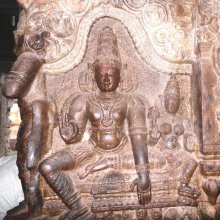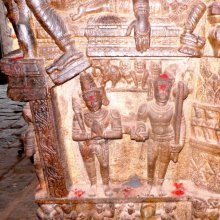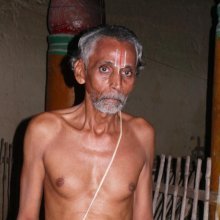Pattabhirama, Paṭṭābhirāma: 4 definitions
Introduction:
Pattabhirama means something in Hinduism, Sanskrit. If you want to know the exact meaning, history, etymology or English translation of this term then check out the descriptions on this page. Add your comment or reference to a book if you want to contribute to this summary article.
Images (photo gallery)
In Hinduism
Vastushastra (architecture)
Source: Shodhganga: Temples of Salem region Up to 1336 ADPaṭṭābhirāma (पट्टाभिराम).—Rāma in the form of Paṭṭābhirāma is seated in vīrāsana. His right hand is in jñānamudra (vyākhyānamudra) and his left hand is jānuhasta. To his left is the seated sculpture of Sītā. She is seated in sukhāsana holding a lotus in her right hand and her left hand is in jānuhastamudra.
Surrounding them are the standing sculptures of Lakṣmaṇa and Bharata who are shown as holding the chatra and cāmara. Śatrughna stands in añjalimudra. Hanumān is shown as seated near the feet of Rāma. He is also in añjalimudra. Inside the sanctum itself sculptures of Sugrīva, Jāmbavān, Aṅgada and Vibhīṣaṇa are kept, suggesting the concept of Paṭṭābhirāma. They are all standing in samabhaṅga and in añjalimudra. The faces of Sugrīva and Aṅgada are carved as monkey faces, while Jāmbavān has the face of a bear, Vibhīṣaṇa is shown with a mustache, probably suggesting that he is a king.

Vastushastra (वास्तुशास्त्र, vāstuśāstra) refers to the ancient Indian science (shastra) of architecture (vastu), dealing with topics such architecture, sculpture, town-building, fort building and various other constructions. Vastu also deals with the philosophy of the architectural relation with the cosmic universe.
Shilpashastra (iconography)
Source: Shodhganga: The significance of the mūla-beras (śilpa)Śrī Paṭṭābhirāma is the name of a deity depicted at the Ranganathaswamy Temple in Srirangam (Śrī Raṅgam), which represents a sacred place for the worship of Viṣṇu.—Here the figures of Sītā, Rāma, Lakṣmaṇa, and Hanumān are found. Rāma and Lakṣmaṇa are found in samapāda-sthānaka with two hands each. The right hand holds the arrow in kaṭaka-hasta and the left hand holds the bow in the dhanur-hasta. Sītā is found to the right of Rāma in samapāda-sthānaka with two hands. The right hand is held in dolā-hasta and the left hand is in kaṭaka-hasta. Hanumān is found in samapāda-sthānaka with hands held in añjali. The sanctums of Śrīnīvāsa Perumāl and Śrī Bhōja Rāma are seen as the devotee proceeds and there is the way out.

Shilpashastra (शिल्पशास्त्र, śilpaśāstra) represents the ancient Indian science (shastra) of creative arts (shilpa) such as sculpture, iconography and painting. Closely related to Vastushastra (architecture), they often share the same literature.
Languages of India and abroad
Sanskrit dictionary
Source: Cologne Digital Sanskrit Dictionaries: Monier-Williams Sanskrit-English DictionaryPaṭṭābhirāma (पट्टाभिराम):—[from paṭṭa] m. Name of an author (also -śāstrin), [Catalogue(s)]
[Sanskrit to German]
Sanskrit, also spelled संस्कृतम् (saṃskṛtam), is an ancient language of India commonly seen as the grandmother of the Indo-European language family (even English!). Closely allied with Prakrit and Pali, Sanskrit is more exhaustive in both grammar and terms and has the most extensive collection of literature in the world, greatly surpassing its sister-languages Greek and Latin.
See also (Relevant definitions)
Starts with: Pattabhirama shastrin, Pattabhiramaprakashika, Pattabhiramashasripattra, Pattabhiramashastrin, Pattabhiramashastripattra, Pattabhiramatippani, Pattabhiramatipparna.
Full-text: Pattabhiramatippani, Nirukti, Pattabhiramashastripattra, Pattabhiramiya, Nyayamanjusha, Vyutpattivadapattra, Caturdashalakshanikroda, Nanvadaviveka, Pattabhirama shastrin, Prakashika, Pattabhiramaprakashika, Prabha, Tarkasamgraha.
Relevant text
Search found 5 books and stories containing Pattabhirama, Paṭṭābhirāma; (plurals include: Pattabhiramas, Paṭṭābhirāmas). You can also click to the full overview containing English textual excerpts. Below are direct links for the most relevant articles:
Smt. K. Savitri Ammal < [July – Sept. & Oct. – Dec. 1992]
Readers Mail < [January – March, 2001]
A Cheerless Wedding < [September 1937]
The Agnistoma Somayaga in the Shukla Yajurveda (by Madan Haloi)
Part 1.2: The common peculiarities of the Saṃsthās < [Chapter 3 - The Somayāga]
Mimamsa interpretation of Vedic Injunctions (Vidhi) (by Shreebas Debnath)
Chapter 7 - Apūrvavidhi (Introduction)
Chapter 4.1 - Subordinateness (Aṅgatva)
Nyaya-Vaisheshika categories (Study) (by Diptimani Goswami)
The Commentaries on Tarkasaṃgraha < [Chapter 1 - Introduction]
Sanskrit sources of Kerala history (by Suma Parappattoli)
9. The Ramavarma-vijaya by Kunan Variyar < [Chapter 3 - Historical Details from Mahakavyas]


